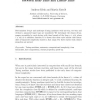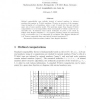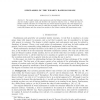50 search results - page 2 / 10 » On the Turing Degrees of Divergence Bounded Computable Reals |
CIE
2007
Springer
15 years 5 months ago
2007
Springer
Abstract. We study existence problems of maximal antichains in the Turing degrees. In particular, we give a characterization of the existence of a thin Π1 1 maximal antichains in ...
JSYML
2008
14 years 11 months ago
2008
We say that A LR B if every B-random number is A-random. Intuitively this means that if oracle A can identify some patterns on some real , oracle B can also find patterns on . In o...
100
click to vote
ECCC
2000
14 years 11 months ago
2000
Deterministic k-tape and multitape Turing machines with one-way, two-way and without a separated input tape are considered. We investigate the classes of languages acceptable by s...
CIE
2009
Springer
15 years 6 months ago
2009
Springer
computability uses ordinals instead of natural numbers in abstract machines like register or Turing machines. We give an overview of the computational strengths of α-β-machines,...
89
Voted
NDJFL
2010
14 years 6 months ago
2010
The weakly random reals contain not only the Schnorr random reals as a subclass but also the weakly 1-generic reals and therefore the n-generic reals for every n. While the class o...



